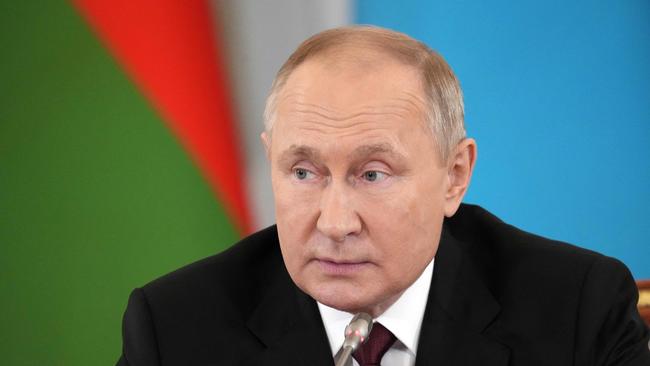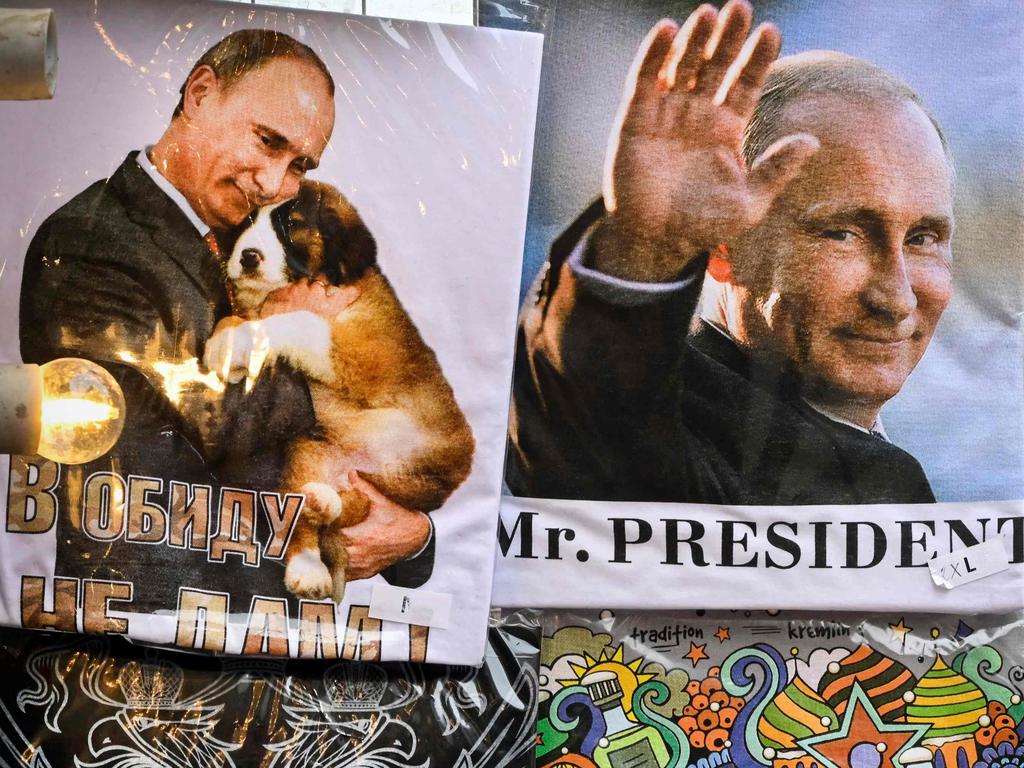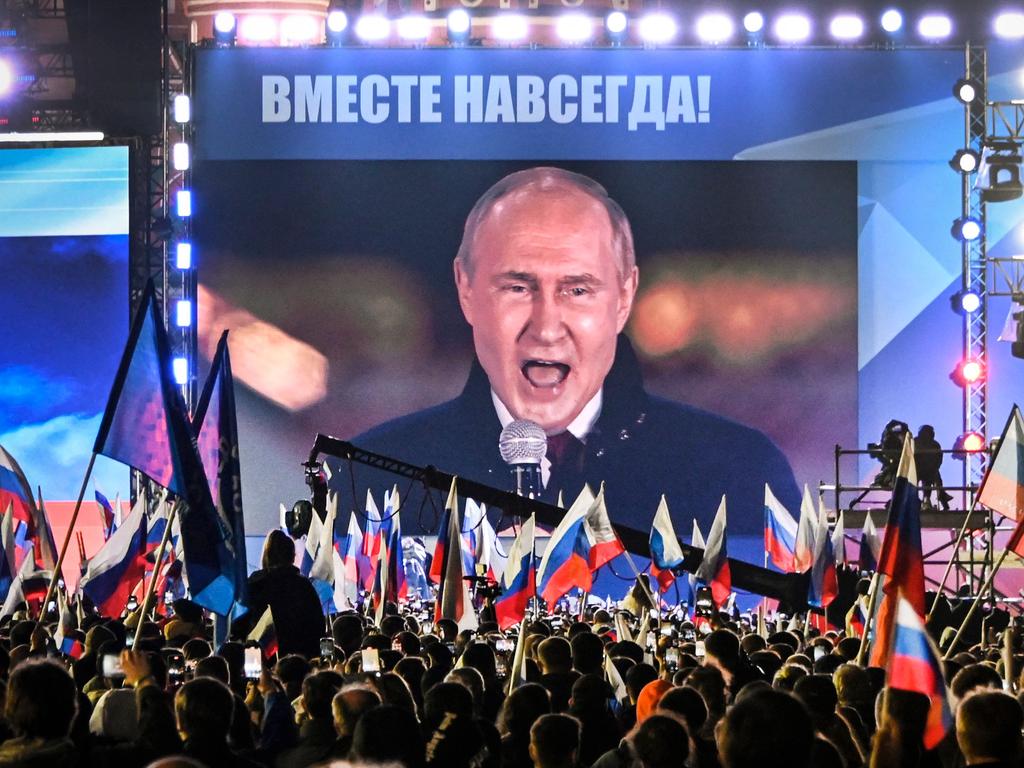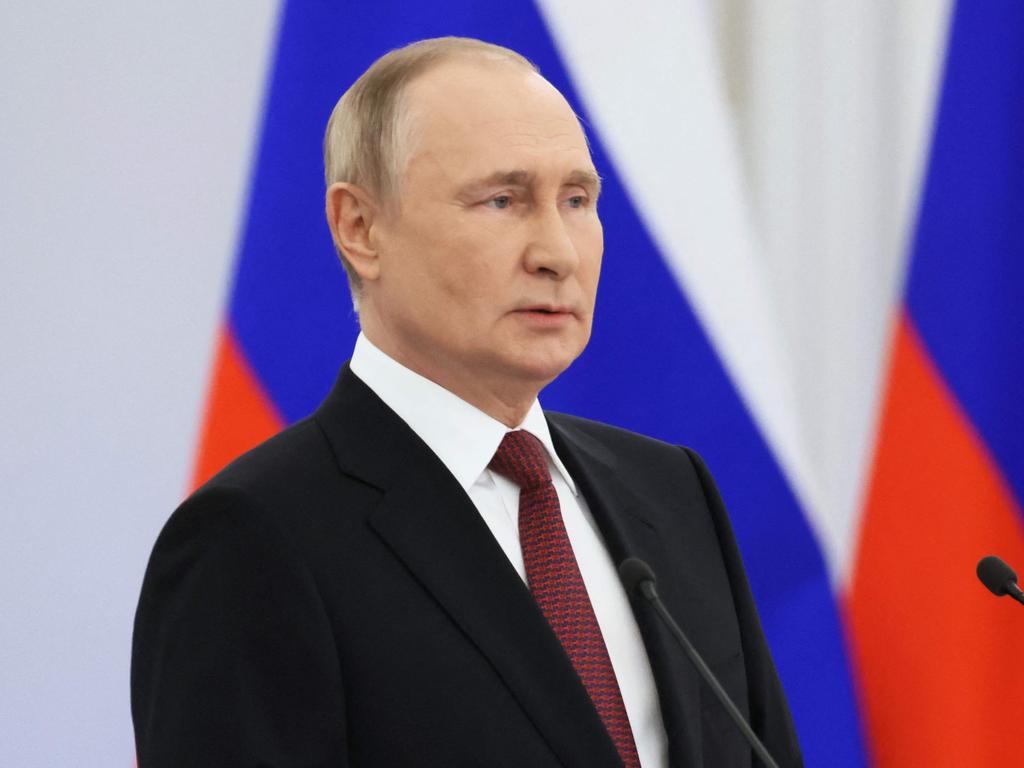Ukraine has finally exposed the fatal flaws in Putin’s army
Russia’s military has had a fearsome reputation for more than a century. Collapsing morale among its poorly equipped and badly led troops raises awkward questions for the Kremlin.

Welcome to the world of the Incredibly Shrinking Russian Soldier. I’m old enough to remember when Ivan threatened to stride with seven-league boots across the north German plains. Those were the days when Nato fretted about the chances of Soviet tanks staging a 48-hour sprint over the Iron Curtain, encircling Hamburg and holding it hostage. Back in 1981 the Pentagon issued a glossy pamphlet, Soviet Military Power, which depicted Moscow’s enormous missiles in lurid detail. It was enough to keep the kids awake at night - and persuade twitchy cold warriors to feed defence budgets in East and West.
And now that fearsome Red Army fighting machine presents itself, rightly or wrongly, as a diminished, almost a pathetic presence. A cache of intercepted phone calls between Russian soldiers in Ukraine and their family and friends reads like a howl of disillusionment. Here’s Sergei to his girlfriend: “Some guys took armour off Ukrainian corpses and took it for themselves. Their Nato armour is better than ours.” And here’s the same Sergei to his mum: “There were 400 paratroopers, and only 38 of them survived . . . because our commanders sent soldiers to their slaughter.”
Soldiers have always complained about their superiors but this running-down of Vladimir Putin’s war effort is becoming critical to his political survival. It is gathering momentum because of the manpower shortage on the various Ukrainian fronts, the poor management of a partial mobilisation and the Kremlin’s loss of what is known as the information space. There are now fierce altercations on state television, open criticism of commanders in the field, arguments on the hyperactive military blogosphere. There is a pervasive sense that the regime has lost its bottle, that elites are wrangling and that Putin, the commander-in-chief, has come adrift.
The self-worth of Russia hangs together with the standing of its army. It’s a relationship that predates communism. After the miserable Russian performance in the Crimean War of the 1850s - three quarters of a million men took up arms and 200,000 were killed - Tsar Alexander II set about reforming the military and modernising the economy. By the turn of that century it seemed the Russian army was one of the great European armies, but it was thrashed in the 1905 war against the Japanese. A pattern established itself: poor generalship led to battlefield defeat, which prompted piecemeal reforms in military education and half-baked social reform, which in turn spurred an outbreak of revolutionary violence and more repression.
The current Ukraine war will probably earn a place in this depressing parade. It begins in 1905 (Russia loses to Japan, has a revolution), staggers into 1917 when Tsar Nicholas II is undone by embittered, unwilling conscripts, a breakdown in supplies, out-of-control food queues and state finances in a mess. War brings inflation and hoarding, inflation drives unrest to the point of no return. In 1905 it was the mutiny against maggot-infested meat on the once proud Battleship Potemkin that pushed Russia’s rulers to the wall. The Bolshevik revolution in 1917 was, in the judgment of the late historian Norman Stone, a “huge mutiny, and though the army did stay at the front, in the summer of 1917 it was quite incapable of offensive action and only barely capable of defensive”.

For Putin there is an even more alarming connection between a disaffected army and stability at home: the 1989 withdrawal of Soviet troops from Afghanistan, the humiliation that was a symbolic prelude to the collapse of the Soviet Union itself. Putin’s wars have over the years sought to compensate, reinventing the armed forces. He promised the generals stability, increased pay, used the rising price of oil to fund kit and army housing. They were incremental steps but came as a relief to the top brass who viewed his predecessor Boris Yeltsin as an erratic amateur. Putin’s plan was banal but easily absorbed: to give the army a central part in restoring national pride and asserting Russia’s dominance of its neighbourhood and the world.
“Russia has been a great power for centuries, and remains so,” he said. “It has always had and still has legitimate zones of interest.” That was in August 1999. Was anyone listening in the West? Not really.
In the Second Chechen War in 1999 Putin (as prime minister but limbering up for the Yeltsin succession) bombarded Grozny, using thermobaric bombs to topple whole apartment blocks. Rebels were hunted down, new weapons including surveillance drones were debuted, special forces picked off Chechen snipers with rocket launchers. It was ugly but it helped establish Putin in the eyes of the West as an ally in the global war against terror. And he was allowed to do it his way; the Chechens had few friends.
The problems with Putin’s war-fighting only became really clear to outsiders when, on the eve of the Beijing Olympics in 2008, Moscow launched a five-day offensive against Georgia. The country was led by Mikheil Saakashvili, westward leaning and determined to operate outside the confines of the Putinsphere. Easy to anger, Saakashvili was Putin’s favourite kind of enemy: effusive, prone to unforced mistakes. His army was puny, barely 30,000 men, and it never stood a chance against the Russians. They planted their flag on two Russian enclaves, in Abkhazia and South Ossetia, installed proxy leaders and didn’t even bother to push on to take the capital, Tbilisi.
Yet that blitzkrieg exposed plenty of weaknesses in the structure of the Russian army. Although it was an operation run by professionals rather than conscripts, it kept blundering. The drones were noisy and easily shot down. Soldiers burned through their ammunition in less than a day, aircraft were downed by friendly fire, the wrong airfields were bombed. Putin was absent, in China. Vehicles were breaking down. It seemed the early Putin attempts at modernisation weren’t up to much.
The shortcomings of the Georgia campaign persuaded Putin to put his foot down. By 2014 he had annexed Crimea without any Russian casualties. Then came the surprise intervention in the Syrian war: Russian aerial bombardment gave the Syrian dictator Bashar al-Assad the necessary push to win the siege of Aleppo. The ruthless Russian mercenary group Wagner defended Assad’s energy installations, the GRU military intelligence gave the regime a protective shield, Russians controlled Syrian air space.
Putin viewed the Syrian intervention as a success of his military reforms. The Crimean annexation justified the chief of staff Vitaly Gerasimov’s case for more hybrid operations. Syria had shown how Russian airpower and urban warfare expertise could be decisive in keeping a friendly dictator in power and preserving Moscow’s Middle East policy. Officers from the Syrian and Crimean 2014 campaigns promptly began to lecture a new generation at Russia’s military academies. Russian arms sales abroad increased steeply. So did the popularity of a military career. The deployment of mercenaries had reduced the risk of being caught in crossfire. Overseas deployment pay rates were high. In 2015 Russian teenagers wanted to be bomber pilots.
What changed? As Mark Galeotti, the prolific chronicler of the Russian security environment, comments in his latest book (Putin’s Wars, 2022), under Putin “the Russian army was saved from collapse; Chechnya pacified, however ugly the means; and Moscow again became a power in global affairs. Had he been content with building a strong nation within its own borders rather than chasing fantasies of empire, Putin would likely have been remembered as a successful state-builder”.
Instead he has been unable to break the blockade that the armed forces have built around their institutions. Their aim is to shield corrupt bookkeeping from public scrutiny, to protect privilege, to fight for larger slices of the budget. Crimea 2014 and Syria 2015 demonstrated to the generals that they were doing something right. Putin agreed.
But this latest iteration of the Ukraine war has highlighted how Putin and the generals have actually failed. There are three essential problems that have been ducked by Putin in 22 years of rule. The first is the dark curtain disguising the length and scope of the mobilisation. There have only been two general mobilisations in Russia - in 1914 and 1941. Neither has happy associations. Putin’s call for a “partial” mobilisation is thus plainly a device to disguise the likelihood of a progression. Western spooks see a difficult Russian winter leading to the special operation in Ukraine being redefined as a counter-terrorism operation. This would enable the regime to declare martial law in those areas closest to the Ukraine border. Changes in the military leadership seem to be in the offing. And there is still the option of closing all non-Asian external borders.
It is this that is driving the exodus of the young, educated middle class to non-EU destinations and other possible safe havens. It’s an exodus that was initially derided by the authorities and is now being hushed up. As is the actual destination and purpose of the 300,000 reservists. In one of the intercepted phone calls, Alexei moans to his partner in Russia: “I didn’t know this was going to happen. They said we were going for training. These bastards didn’t tell us anything.”

The conversations, monitored by Ukrainian intelligence and vetted by a team from The New York Times, were recorded in March and the talk is of massacres, random shootings of Ukrainians, frostbite and looting. The regiments involved include units previously considered among the elite of the Russian army, including the 331st Guards Airborne Regiment. Smartphones and troops with no messaging discipline are forcing this almost real-time candour on pockets of Russian society. It has become impossible even for tightly controlled state television to ignore.
But the criticism of the war comes from all corners of the armed forces, even those who actually want to fight but feel thwarted by the meltdown inside the military hierarchies. On social media, newly mobilised reservists in the city of Kazan have been publicly complaining to local military authorities. They demand real military training before being sent to Ukraine. Instead, they say, they are being put on parade, judged for their bed-making and pointlessly punished. “The worst part is that there’s no real combat training. We haven’t fired a single shot in a week,” said one. “We were just taken to a firing range and were given theoretical classes as if we were just conscripts. Today we spent three hours drawing a weapon from the armoury, four hours on parade, and then another three hours returning the guns.” They fear they are being lined up as cannon fodder.
“We are not draft dodgers, we’re answering the call of the motherland, although many of us have health exemptions or deferments. But we don’t want to go to the front as untrained meat.”
This then is not a pacifist revolt in Russia, the makings of an anti-war movement. Rather it’s a snowballing anger at the incompetence of the war effort, and that could be even more dangerous for Putin. One secretly recorded video shows a regimental commander greeting a handful of reservists. “I don’t know your mission,” he tells them. “I don’t know what equipment is available.” He himself was pulled back from holidays, has health issues. Maybe they will be on the front in 30 days. Maybe not. He will lead them; maybe not. This is not, it’s fair to say, the way to boost troop morale.
Apart from this mass deception of future troops, there is the question of barrack-room culture that is contributing to the brutalisation of battlefield behaviour. The practice of dedovshchina - bullying of junior recruits by their elders - was a problem throughout the Soviet years. Young recruits are forced to make the beds of older soldiers, polish their boots, lay a cigarette under their pillows, surrender any food parcels from home and be ready for a beating if they are slow to respond. Some say the practice began in 1967 when conscription was changed from three years in the army (four for the navy) to two years (later reduced to one year). It’s a consequence, say military scholars, of four different intakes sharing quarters: those who have just been brought in, those who are about to complete their service and two further cohorts. It matters not just because of the violence (in a single year 800 servicemen were killed by other soldiers) but because it points to one of the reasons why Russians flounder on the battlefield: the lack of NCOs in the barracks. Officers have become dependent on the old lags keeping order. Putin’s solution, to set up guardrooms to punish thuggish behaviour, barely scrapes the surface of a serious issue.

Finally, there is the problem of creating a Russian military identity. The army has been recruiting Tajiks and Dagestanis and other central Asians since Soviet days: their usually small frame fits more easily into the tight turrets of early model Soviet tanks. There was racism in the Soviet ranks and it still persists. They dominated the casualty lists in the early days of this year’s war; they’re still being lured into the ranks with salaries which are several multiples the local wages. But the overall impression of the battlefield is that for an army whose generals follow the call for Slav unity they are a pretty mixed bag. Not just the local Asian recruits, but private military contractors and fighters from the Donetsk and Luhansk regions: all differently trained and with no particular loyalty to the regiment or unit. It is the atomisation of the Russian army that has sapped its morale.
Putin’s mobilisation can be seen as a willingness and ability to keep fighting into 2023. But the numbers only matter if they have the training, the supplies, the fighting spirit. That may be on the optimistic side. One soldier filmed himself the other day after being issued with two left boots. It turned out that everyone in his platoon was assumed to be without a right foot to stand on. They’d be better off packing running shoes.
The Times







To join the conversation, please log in. Don't have an account? Register
Join the conversation, you are commenting as Logout